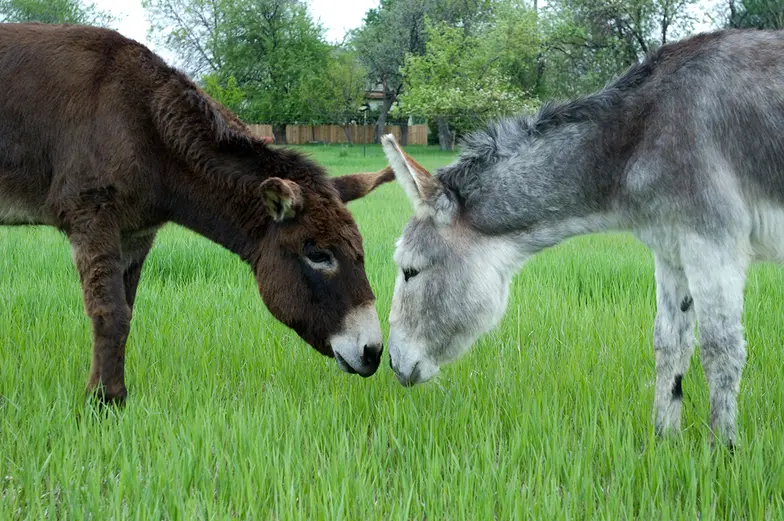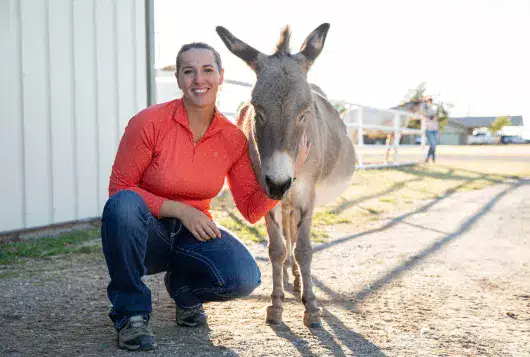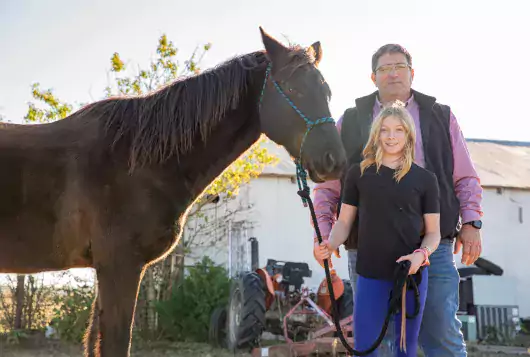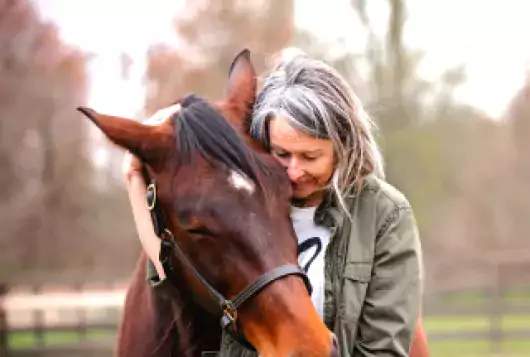Ten Ways Donkeys Are Different From Horses

Donkeys and horses have differences that extend beyond a loud bray and adorably outsized ears – and a donkey’s unique characteristics need to be considered when providing medical care or doing any rescue or rehoming work. Here are 10 things about donkeys you should know.
They Use Stoicism As A Defense Mechanism
Appearing strong and normal can reduce the chance that donkeys will be preyed upon in the wild. This doesn’t mean they aren’t experiencing pain or discomfort – they just aren’t expressing it as clearly as a horse would.
Also, donkeys have a more insensitive cough reflex than horses, so respiratory disease often goes unnoticed until it is more severe. A donkey who is dull or unusually quiet is a veterinary emergency.
They Bond In Pairs Or Small Groups
Donkeys don’t form large herds in the wild due to generally limited foodstuffs. They tend to form small groups or pairs and bond with one other donkey, so it’s best not to separate bonded pairs.
When examining a donkey, it’s a good idea to bring his or her buddy along. That can keep the donkey calmer and reduce stress all around.
They Need Larger Doses Of Pain Meds
Donkeys have an increased drug metabolism rate compared to horses. Most NSAIDs need to be administered twice daily with donkeys, rather than once daily, as is common for horses. Donkeys also require more frequent administration of sedatives and anesthetics than horses.
They Have A High Risk Of Hyperlipidemia
Any disease or problem that causes decreased food intake can result in hyperlipidemia in donkeys, especially those who have risk factors such as pregnancy, lactation, obesity, advanced age or inadequate exercise.
A donkey who is diagnosed with colic, PPID, EMS, laminitis, is stressed at the loss of a bonded companion or has been in an aggressive weight-loss program (a donkey shouldn’t lose more than 2-3% of body weight per month) should be checked for hyperlipidemia as a complicating factor.
Note: Anorexic donkeys will “sham eat” by grabbing very small amounts of food, making chewing motions, and even swallowing without ingesting much food. Make sure to watch sick or stressed donkeys closely to see that they are actually eating.
Donkeys are not just horses with big ears – they have unique characteristics that impact how caregivers assess their health and wellbeing.
They’re Not Necessarily Stubborn
Because donkeys’ body language is different than horses, reluctance is often misinterpreted as stubbornness. A “stubborn” donkey is most likely avoiding a fear-inducing situation or is not motivated to do an activity.
Their Coat Can Mask Problems, Block Meds
Medications that are applied topically often won’t be able to disperse throughout the furry haircoat and won’t work properly.
On top of that, the longer hair can hide wounds, skin conditions and extreme thinness. Donkeys should have their skin closely examined. Body condition scoring should be done on every donkey entering rescue and should be done by physically palpating physical landmarks on the donkey, not by sight alone.
They Require Extra Caution With Castration
Castration of donkey stallions is recommended at 6-18 months of age. Donkeys are more likely to show undesirable behavior after castration than horses are, especially if they are gelded after 18 months of age. There is an increased risk of bleeding and the arteries need to be individually ligated.
They Have Special Hoof Needs
Donkeys have different hoof conformation, so it’s important your farrier is aware of the unique needs of donkeys when trimming hooves. Lame donkeys often don’t respond to hoof testers, so interpret these findings with care.
Because of differences in hoof structure, donkey feet look different on radiographs and care needs to be taken in interpreting them using donkey normal values. Additionally, frog support is not appropriate for donkeys with laminitis.
They Have High Risk With Extra Weight
Donkeys evolved to live in an environment with sparse food and limited water, so carrying extra weight can predispose them to a host of physical problems. Because donkeys love to chew for 14-18 hours a day, they should be provided with high-fiber substances such as straw, hay, leaves and branches of nonpoisonous plants.
You can also use slow feeders or small-holed hay nets to satisfy their need to chew without increasing their food intake. Without appropriate forage, donkeys will start chewing on stalls, barns, fences, etc. to satisfy this behavioral need.
They Have Specific Hold Needs
Never use ear twitches on a donkey because they can cause significant pain.
Head holds are often very effective for donkey restraint, as is having an additional calm donkey nearby. If additional restraint is needed, sedation may be advisable, if safe to do so.
Picking up a front foot can help to limit movement but is not effective in keeping a donkey from kicking. They can balance on two legs and still accurately kick out with the back or front feet.
Want to learn more about donkey welfare? Register for the 7th annual Donkey Welfare Symposium at the University of California, Davis from Sept. 13-14, 2019.
We have lots more on this subject:




